At the end of June, I attended a technology and education conference in San Diego and had the great fortune to meet Peter H. Reynolds, a fantastic children’s author and illustrator, perhaps best known for his picture books The Dot and Ish, at the Upstart Crow Bookstore right next to my hotel. I detailed my family’s first exposure to Peter Reynolds in a post back in February about Plant a Kiss, a really warm, inventive picture book illustrated by Reynolds and authored by one of my daughter’s favorite writers, Amy Krouse Rosenthal.
In that review, I commented that:
Illustrator Peter Reynolds is also a pretty big deal in children’s lit – his picture book, The Dot, is supposed to be fantastic – but, I’d admit, he’s one of those children’s book creators whom we’ve somehow missed entirely. Plant a Kiss is actually the first Peter Reynolds book we’ve ever read (it won’t be the last)…
After reading Plant a Kiss, during our very next trip to our library, my daughter saw a copy of The Dot on the shelves and, recognizing the artist, asked if we could check it out. Three weeks later, when we had to return The Dot to the library, my daughter brought the book over to the children’s librarian and asked if they had any more books by Peter Reynolds. Coming from a five year old, that’s a fairly huge endorsement.
Reynolds is a bit of a renaissance man. Aside from writing and illustrating his own children’s books – titles like The Dot, Ish, So Few of Me, and The North Star – he’s also illustrated the Judy Moody series by Megan McDonald, Someday by Alison McGhee, and a whole host of other titles by authors like Rosenthal, Gerda Weissman Klein, Bob Raczka, Eleanor Estes, and Judy Blume, among others. As if that’s not enough, he’s also the co-founder of FableVision, Inc., a “turn-key educational media developer and publisher committed to creating positive programming and products that help all learners navigate their full potential.” (I’m not entirely sure what that means, but it sounds fascinating.)
There are many reasons why I think my daughter really liked The Dot. It’s a wonderfully illustrated story. It has a very relatable protagonist – a young girl named Vashti, who is convinced that she simply CAN’T draw. And it has a very strong message at its core about creativity, confidence, and using art as a means to express one’s self.
Personally, one of the major reasons why I liked The Dot so much was because it was came along at the perfect time in my daughter’s life. My daughter just graduated from kindergarten back in June and she was one of the younger students in her class. (Just FYI, new parents – the debate surrounding whether you should send children with late-in-the-year birthdays straight to kindergarten or to a “Young Fives” program first is EASILY the most contentious parenting issue I’ve ever encountered. Certain parents go NUTS when the topic is brought up. I understand about being defensive about choices you’ve made for your family, but, jeez…)
Because my daughter was almost a year and a half younger than some of her classmates, there were some developmental differences we noticed between her and some of the older students in her class. Yes, my daughter could read them all under the table, was great with numbers, and has memorized Batman’s almost entire rogue’s gallery (reminder: nerd dad), but, in terms of motor skills, my kid was undeniably on the younger side, particularly when it came to handwriting and coloring in the lines.
And, because such things are inevitable, one of her classmates picked up on this and began to tease her. He laughed at her pictures, he called her a “scribble-scrabbler”, and he called her a baby. The little jerk even picked up a term used by their teacher and weirdly chided my daughter for “not producing quality work.” (I won’t even tell you the names I told my daughter to call him back in return. Honestly. I really can’t. Whenever I tell people, I never come out looking good.)
As a result, my daughter very, very quickly became intensely self-conscious about her writing and drawing ability. She stopped coloring. When she did draw a picture, she’d constantly criticize herself. She’d put her head down on the table and lament that it wasn’t supposed to look like that. It was painful to watch. And, around this time, my daughter got her copy of Plant a Kiss, became a fan of Peter Reynolds, and checked a copy of The Dot out from our library.
Now I’m not going to claim that The Dot cured my daughter’s social anxiety, taught her to love her own unique artistic vision, and solved all her problems. That’d be dishonest. No book can do all that all on its own. But what I will say is that The Dot came along at the PERFECT time for my daughter. We NEEDED a book like The Dot in our home library. It was the ideal representation of an actual problem we were having in our home.
I expected to deal with a lot of issues when I became a parent – body image issues, friendship drama, explanations involving birds and/or bees – but the one issue I didn’t really anticipate was artistic anxiety. It never occurred to me that a child’s ability (or inability) to draw a house or color in a picture of a dinosaur could lead them into a full-fledged existential crisis.
Like my daughter, Vashti – the lead character of The Dot – was convinced that she couldn’t draw. Her art teacher implored Vashti to “Just make a mark and see where it takes you.” Vashti jabbed the paper with her pen, made a tiny ink dot, and declared, “There!” She’d fulfilled her teacher’s bare minimum requirement for the assignment. She was done. Her teacher, however, showed interest in the little dot and asked Vashti to sign her new minimalist piece of artwork – like an artist would sign a masterpiece.
The next week, Vashti shows up to class and her teacher has framed her dot picture in a semi-ornate frame and displayed it prominently on the wall. This act confuses Vashti. She can’t understand the value her teacher sees in the picture and she quickly starts thinking, “Well, c’mon, I can do better than that…” So, Vashti starts drawing dots, painting dots, sculpting dots. Creating these dots lights a fire under her creatively. Even though, she’s still just drawing something as simple as a dot, she learns to find joy and fulfillment through the process of creating, experimenting, and finding new and exciting ways to bring her own personal interpretations of dots to life.
Reynolds also created a thematic sequel to The Dot called Ish, which was almost even more applicable to my daughter’s situation. A boy named Ramon loves to draw – that is, until his brother teases him about one of his drawings. (He claims that Ramon’s picture of a vase of flowers doesn’t look anything like its subject.) This off-handed comment makes Ramon extremely critical of his own artwork and sucks away all of the fun he used to have while drawing. It’s not until Ramon discovers that his sister has been saving all of his discarded drawings that the boy begins to realize that his artwork has an inherent value and that not all art HAS to be an exact physical representation of its subject. Artwork can take liberties, exaggerate, embellish, expand, and embody the spirit of an object. His picture didn’t have to look exactly like a vase. It could have just as much value, even if it only looked vase-ISH. And, even though his brother might not like his ish-drawings, other people did and that helped him realize their worth.
Like I said, The Dot and Ish didn’t magically cure my daughter of her anxieties. They still emerge from time to time. She draws something and then immediately crumples it up. She grumbles to herself that all of the other kids in her class can draw better than she can. But The Dot and Ish DID give my wife and I a much more compelling vocabulary to talk to our daughter about the problem. Both books were EXTREMELY relatable to what she was going through, so we found ourselves saying, “This is just how Vashti felt!” or “Remember when Ramon…” And our daughter responded to those comparisons. She understood them and she liked them – because she liked the books so much. And, while I won’t give Reynolds all the credit, over the past few months, she has become much more confident and self-satisfied with her artistic efforts. She’s spending more and more time drawing and coloring for fun, which she barely did during the worst of the “scribble-scrabbler” period.
Basically, in my mind, The Dot and Ish are the two fables that, as parents, we didn’t even know we needed. There are libraries full of fables, stories, and allegories to teach kids manners, to tell them not to be afraid of the dark, to make them feel better about the first day of school or their unconventional family, and so on and so forth. But there aren’t many fables or stories that I’m aware of that focus on artistic creativity. Sure, there are tons of “believe in yourself” stories, but I can’t name many stories that try to convey the complexity of artistic inspiration or that try to teach kids to stop judging themselves and learn to enjoy the creative process for what it is. And, as a parent, I don’t have many books in my parenting toolbox that I can use in discussions about art or creativity. Or that convey some very astute points about how to develop an environment of creativity in your home.
For all of those reasons, I’m very happy that my daughter has now discovered Peter Reynolds and that we now have copies of The Dot and Ish in our home library. On one level, they’re just really well told and attractive picture books. On another level, they’re excellent catalysts for conversations about creativity, which are really fun conversations to have.
THE DETAILS ON THE DOT AND ISH
AGE RANGE: I’ve seen 5 and up as a stated age range, but these are very gentle, accessible books. I’d be entirely comfortable reading these books to a two year old. Granted, there are deeper themes within both books that a child might not fully grasp until they’re a little older, but I think these are fantastic books to read to younger kids, particularly if they’re fond of drawing.
PAGE COUNT: 32 pages (each)
RELATED WEB SITE: Here’s a link to the official website of Peter H. Reynolds, where you’ll find a wealth of information on all of his books, and the Candlewick publisher site for The Dot has some good teacher guides and resources for both books. There is also an official annual event built around The Dot called International Dot Day. It takes place every year on September 15-ish with the expressed purpose to help educators “encourage their students’ creativity.” For more information on the plans for International Dot Day 2012, click here.
BUY IT, BORROW IT, OR FORGET IT?: Personally, I think these are very solid selections for any developing home library and I’d buy them. They’re very smart, subtle books about inspiring creativity that don’t get schmaltzy or didactic. That’s really rare. I’m glad we own them.
IF YOU LIKED THE DOT OR ISH, YOU MIGHT ALSO LIKE:
- Iggy Peck, Architect by Andrea Beaty, illustrated by David Roberts – This remains one of my favorite picture books ever suggested by a reader of this blog. Iggy Peck is obsessed with architecture and finds ways to build amazing structural designs out of any object he encounters. But when his strident second-grade teacher tries to rein in his passion for architecture, will he give in or will he teach her to see what he sees? This is a fantastic book about artistic expression and it’s absolutely gorgeous to boot. Roberts is an uber-talented illustrator who incorporates fantastic details throughout the text. (I love the graph paper backgrounds.)
- Seen Art?, by Jon Scieszka, illustrated by Lane Smith – This is an odd little picture book that my daughter adores. (It might be one of our most frequently checked out books from the library.) To commemorate the opening of the new location of New York City’s Museum of Modern Art in late 2004, Scieszka and Smith created this long, thin tribute to the museum, in which a young boy, looking for his friend Arthur, gets directed into the new MoMA building after asking around, “Seen Art?” He eventually wanders through the museum – the book features some wonderful reproductions of many of the museum’s most notable pieces – learning while he goes how other people define what exactly “art” is. It’s a great primer for teaching kids how to appreciate and talk about art. And it’s the reason why my five year old can recognize an Andy Warhol or Roy Lichtenstein print on sight.
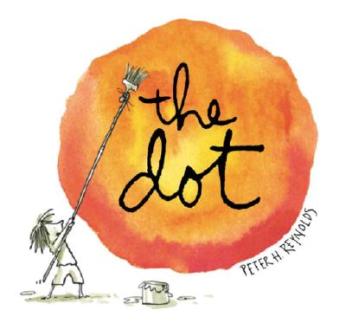
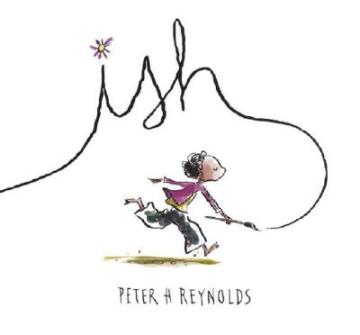
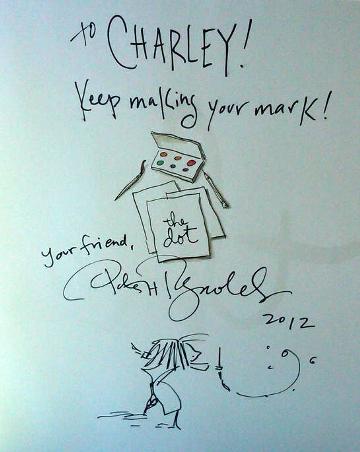
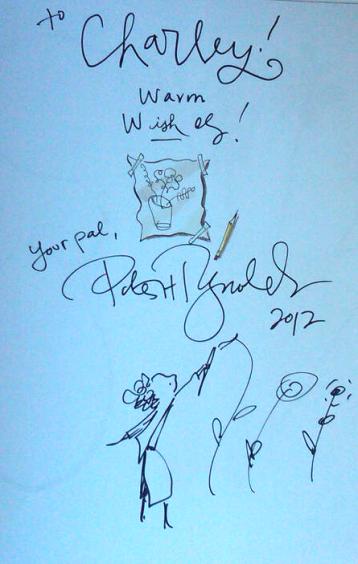
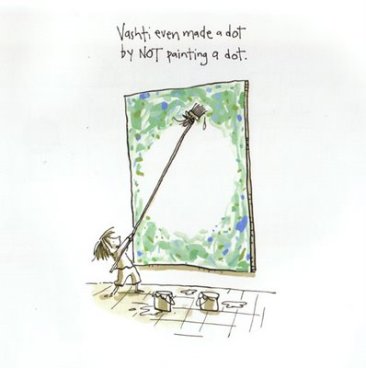
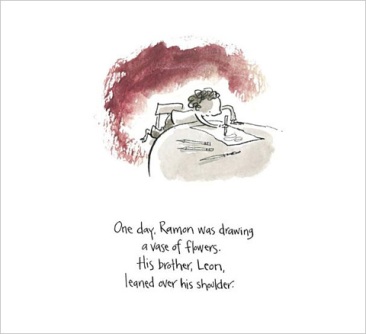
{ 5 comments… read them below or add one }
What a wonderful article, Tom, and one I will share with the K teachers in my buildings. They are soooo effing hung up on this issue and when they show me prospective future evaluee’s pics, I always say “Cool. Now let them dictate their story about the picture to you and have them read it to you or with you.” It’s called validation. Thanks for sharing.
Hey Tom,
Thanks for posting this. My 4 year old *needs* her art to be perfect and become very upset when a dot is misplaced. Checking these out immediately.
Betsey (from K!)
Yay! Good to hear from you, Betsey!
I think your daughter will dig these books. They do a really great job of celebrating the messy individuality of making art without being preachy or overly hippy-dippy. They’re cool reads.
So glad you found these books just when your daughter needed them but so sorry to hear that name calling has caused her to stop creating. I can’t believe that begins in kindergarten.
I don’t want to make it sound worse than it was. It wasn’t a full-fledged campaign of terror or anything. But it was one kid very clearly noticing one of my daughter’s weak areas and deciding that he was going to poke the wound. He saw an in and he went for it. She didn’t come home crying every day, but you could see her become more and more self-conscious about everything she drew. She was constantly comparing her artwork against other kids in her class and, after she’d draw something, she’d just sit there looking at it and sigh loudly. His comments got under her skin and were making her doubt herself.
And, yes, my daughter is on the young side when it comes to motor skill development for her age, so there are kids in her class who are much stronger than her when it comes to coloring in the lines, making crafts, and drawing objects. So, while we’re continuing to work her on her motor skills, we’ve been struggling to find ways during this process to make drawing, painting, and creating art fun. For a long time, picking up a pencil or a crayon just felt like work to my daughter. And, so far, we’ve found that books like The Dot and Ish have been big, big helps in reigniting her passion for coloring, sketching, and having fun with art supplies.
You must log in to post a comment.